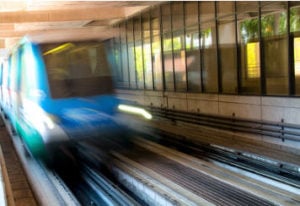Since the earliest mass-transit systems, it has been understood that the property adjacent to train stations is particularly well-suited for dense mixed-use  development. People are willing to pay a premium for the convenience of living near public transportation, and since the goal of mass transit is to efficiently move people from where they live to where they work and back, it makes sense to build both housing and office developments adjacent to stations. The contemporary term for this type of development is transit-oriented development, or TOD.
development. People are willing to pay a premium for the convenience of living near public transportation, and since the goal of mass transit is to efficiently move people from where they live to where they work and back, it makes sense to build both housing and office developments adjacent to stations. The contemporary term for this type of development is transit-oriented development, or TOD.
During the 1970s and 1980s, when the federal government funded new mass transit systems throughout the country (including here in Miami), there was an expectation that the cost of operating and maintaining the systems would be eventually covered by TOD and “value capture.” In essence, the TOD would be added to the tax rolls, and the additional real estate taxes collected by local governments would cover the cost of running the trains. In addition, the TOD would increase ridership (if more people live next to the station, more people will ride the train), and therefore increase revenues from passenger fares. In fact, when Miami’s Metrorail system was designed in the late 1970s, Miami-Dade County adopted a new zoning ordinance for the property adjacent to the entire system specifically to facilitate new TOD in order to help fund the system. Unfortunately, in both Miami and elsewhere throughout the country, many planned TODs were never built, and the transit systems have therefore been underutilized and underfunded.
Elsewhere in the world, TOD has been used very effectively to not merely help put more bodies on the trains and defray operation costs, but to fund brand-new systems. In Hong Kong, the entire subway system has been funded through a public-private partnership premised on TOD. MTR, the operator of the subway, funds the construction and ongoing maintenance of the public-transportation system by developing high-rise development over and adjacent to the stations. This system, called “rail plus property,” has proven to be remarkably effective, and it has recently been employed with success in mainland China as well and is on its way to being exported elsewhere around the world.
Faced with a shortage of public dollars to fund existing and new mass transit systems, governments throughout the world have begun to look towards TOD, which is a proven answer that has been hiding in plain sight for decades. Locally, Miami-Dade County has recently approved leases for TOD at the Douglas Road and Coconut Grove Stations. Meanwhile, the property above and adjacent to several other stations in the Metrorail system remains undeveloped: new TOD at these stations is a low-hanging fruit for increasing ridership and funding future expansions of the system, including the recently adopted SMART plan for several new lines throughout the County. As just one example of the expansion of TOD globally, the East Japan Railway recently announced its plans to construct a new station that will see 130,000 passengers a day, along with 1.4 million square feet of new TOD–essentially a new town served by and contributing to the public-transportation system.

